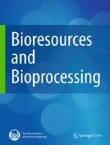Bioresources and Bioprocessing is associated with the State Key Laboratory of Bioreactor Engineering, East China University of Science and Technology.
Green biomimetic synthesis of Ag–TiO2 nanocomposite using Origanum majorana leaf extract under sonication and their biological activities
Studies of plant extract-mediated synthesis of nanoparticles is extensively explored and studied in recent time due to eco-friendly, cost-effectiveness and minimal use of toxic chemicals for synthesis. In this...












































